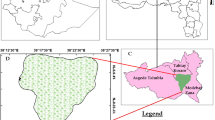Abstract
Vegetation pattern and microtopography were examined on a mountain slope with a rotational type landslide scar on Mt Kiyosumi, central Japan. Similarities of distribution patterns among 55 woody species were calculated using Cole's species association coefficient, and based on them, seven vegetation units were classified using cluster analysis and principal coordinates analysis. The seven vegetation units coincide with seven microtopographical facets at 101 to 102 m2 order. Furthermore, these vegetation units were grouped into three higher categories by reciprocal averaging and principal coordinates analysis. They were ridge slopes, surrounding slopes and landslide slopes. The three categories were arranged in the above-mentioned order based on similarity in floristic composition. In the ridge slopes, late-successional trees and deciduous trees had high relative basal areas. In the surrounding slopes,Euptelea polyandra and other deciduous trees had high relative basal areas. In the landslide slopes,E. polyandra and deciduous shrubs had high relative basal areas. The density and the age distributions ofE. polyandra, a typical pioneer tree which invades disturbed sites, suggested that the severity of soil surface disturbances increase in this order. The disturbance regime explains the vegetation pattern on the study site, where the rotational type landslide had occurred.
Similar content being viewed by others
References
Cole L. C. (1949) The measurement of interspecific association.Ecology 30: 411–24.
Cole L. C. (1957) The measurement of partial interspecific association.Ecology 38: 226–33.
Connell J. H. (1978) Diversity in tropical rain forests and coral reefs.Science 199: 1302–10.
Connell J. H. &Keough M. J. (1985) Disturbance and patch dynamics of subtidal marine animals on hard substrata. In:Natural Disturbance and Patch Dynamics (ed. S. T. A. Pickett & P. S. White) pp. 125–51. Academic Press, Orlando.
Cooke R. U. &Doornkamp J. C. (1974)Geomorphology in Environmental Management. (Clarendon, Oxford.
Drury W. H. &Nisbet C. T. (1971): Inter-relations between developmental models in geomorphology, plant ecology, and animal ecology.General Systems 16: 57–68.
Flaccus E. (1959) Revegetation of landslides in the White Mountains of New Hampshire.Ecology 40: 692–703.
Garwood N. C., Janos D. P. &Brokaw W. N. (1979) Earthquake-caused landslides: A major disturbance to tropical forests.Science 205: 997–9.
Gower J. C. (1966) Some distance properties of latent root and vector methods used in multivariate analysis.Biometrika 53: 325–38.
Guariguata M. R. (1990) Landslide disturbance and forest regeneration in the Upper Luquillo Mountains of Puerto Rico.J. Ecol. 78: 814–32.
Hack J. T. &Goodlett J. C. (1960) Geomorphology and forest ecology of a mountain region in the central Appalachians. Ecological survey professional paper, 347, 66 pp. US Government Printing Office, Washington, DC.
Hill H. O. (1973) Reciprocal averaging: An eigenvector method of ordination.J. Ecol. 61: 237–49.
Iijima A. &Ikeya N. (1976) Geology of the Tokyo University Forest in Chiba. The miscellaneous information, Tokyo University Forest,20: 1–38.
Kikuchi T. (1985) Small- and micro-scale distribution pattern in vegetation.Quat. Res. 24: 215–20 (in Japanese with English summary).
Koop H. (1987) Vegetation reproduction of trees in some European natural forests.Vegetatio 72: 103–10.
Langenheim J. H. (1956) Plant succession on a subalpine earthflow in Colorado.Ecology 37: 301–17.
Nakamura F. (1990) Perspectives for the effects of geomorphic processes,Biological Science 42: 57–67 (in Japanese).
Pielou E. C. (1977)Mathematical Ecology. Wiley-Interscience, New York.
Sakura T. &Numata M. (1973) Recovery of vegetation in the area of mountain landslide in the south-east part of the Boso peninsula.J. Jap. For. Sci. 55: 361–7 (in Japanese with English summary).
Shimokawa E. &Jitousono T. (1984) Residence time of soil on slopes and Yaku-sugi (Cryptomeria japonica) in the Yaku-shima Wilderness Area, Yaku-shima Island. Conservation reports of the Yaku-shima Wilderness Area, Kyushu, Japan, 83–100. Nature Conservation Bureau, Environment Agency, Japan (in Japanese with English summary).
Stevens G. C. &Fox J. F. (1991) The causes of treeline.Ann. Rev. Ecol. Syst. 22: 177–91.
Swanson F. J. (1980) Geomorphology and Ecosystems. Forests: Fresh perspectives from ecosystem analysis. Proceedings of the 40th annual, biology colloquium. pp. 159–70. Oregon State University Press, Corvallis.
Tohei R. (1979) Vegetation around valleys in Boso Hill Region (I). Forests on slopes around Tsuboisawa.Chiba Seibutsushi 28: 37–47 (in Japanese).
Tokyo University Forest in Chiba (1986) Vegetation map of the Tokyo University Forest in Chiba (1985). The Tokyo University Forest, Tokyo.
Tokyo University Forest in Chiba (1987) Meteorological data of the Tokyo University Forest in Chiba (1975–1984). Miscellaneous Information, the Tokyo University Forests25: 49–59.
Varnes D. J. (1978) Slope movement types and processes. In:Landslides: Analysis and Control (ed. R. L. Shuster & R. S. Krizek) pp. 11–33. Special Report, 276. United States National Academy of Sciences Transportation Research Board, Washington, D. C.
Veblen T. T. &Ashton D. H. (1978) Catastrophic influences on the vegetation of the Valdivian Andes.Vegetatio 36: 149–67.
Veblen T. T., Schlegel F. M. &Escobar B. R. (1980) Structure and dynamics of old-growthNothofagus forests in the Valdivian Andes.Chile. J. Ecol. 68: 1–31.
Author information
Authors and Affiliations
About this article
Cite this article
Sakai, A., Ohsawa, M. Vegetation pattern and microtopography on a landslide scar of Mt Kiyosumi, central Japan. Ecol. Res. 8, 47–56 (1993). https://doi.org/10.1007/BF02348606
Accepted:
Issue Date:
DOI: https://doi.org/10.1007/BF02348606




